Why does spathiphyllum ("female happiness") not bloom and how to properly care for it?
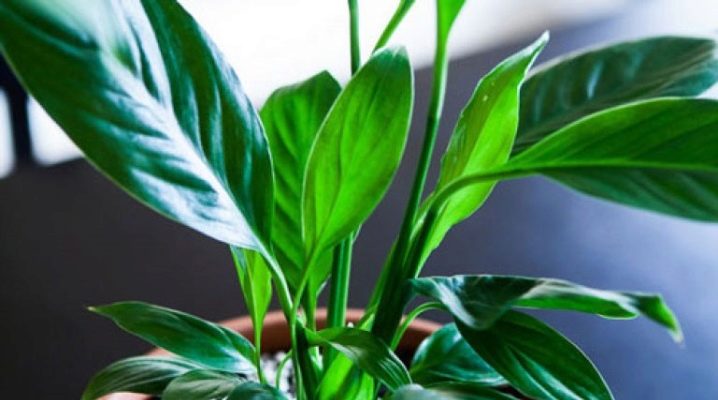
Spathiphyllum belongs to the Aroid family, is an evergreen plant with flowers that look like calla lilies. The common people called the culture "female happiness". According to legends, placing a flower in the house of a lonely girl will help her find a soul mate. Sometimes it happens that a plant loses the opportunity to delight flower growers with its snow-white flowers. What is the reason for the lack of flowering of spathiphyllum and how to fix it, it is worth considering in more detail.
Features of the flowering process
Flowering is a physiological process of a plant associated with a generative reproduction method. It proceeds in the form from the inception of flower ovaries to their opening. The development of buds proceeds in different ways, each culture has its own characteristics. At first, the plant grows actively, turning into an adult, formed individual. Then indoor spathiphyllum begins to form inflorescences on legs, the tips of which are covered with white hoods. Young plants bloom at about 2 years of age.
If the flower is placed in favorable conditions, flowering occurs in the spring months and ends in the fall.
Further, the plant needs a dormant period to gain strength and reproduce re-flowering the following year. There are times when the culture blooms after a short dormancy in the autumn season. To admire the unique flowers, spathiphyllum requires special care, tied to the amount of moisture in the soil and the environment. Long-term exposure to improper care leads to the inability of the plant to set in the axils of the peduncle leaves.

Why doesn't it bloom?
The reason for the lack of flowering at home can be: lack of daylight, too humid or dry air, irregular watering or excess fertilizer, improper crop transplant. Let's consider each item in more detail.
Releases leaves
The culture looks healthy outwardly: the presence of a green tint, the standard size of the leaf plates, the constant build-up of young shoots, but only produces leaves. These manifestations are associated with an excess of mineral elements in the substrate, in other words, the plant "fattens". Top dressing based on nitrogenous substances stimulates foliage growth instead of flowering. To change the situation, it is recommended to replace fertilizers with potassium-phosphorus fertilizers, these substances are actively involved in the formation of flower buds. If the culture gives unhealthy foliage, that is, the leaves are too small, of a different shape, discolored, etc., then this problem is associated with a violation of the irrigation cycle, lack of moisture, excess dust and dirt on the leaf plates. When identifying an ailment, it is worth paying special attention to the plant.

Lighting
"Women's happiness" is recommended to be placed in shaded areas. With a large amount of direct sunlight, the culture is prone to drying out, loss of turgor, loss of strength necessary for growth and flowering, rapid drying of the earth, and the formation of burns on the leaves.
The most suitable option for placing a flower would be to find its container 1–2 m away from the window, if the side is south, on the windowsill - with northern windows, location on a stand or window - with the west or east side.
Signs of a lack of daylight are as follows:
- sheet plates are stretched, take on an oblong shape;
- cessation of the formation of flower ovaries in the leaf axils;
- growth inhibition.
This ailment is treated by rearranging the culture in a lighted area or installing a phyto-lamp.
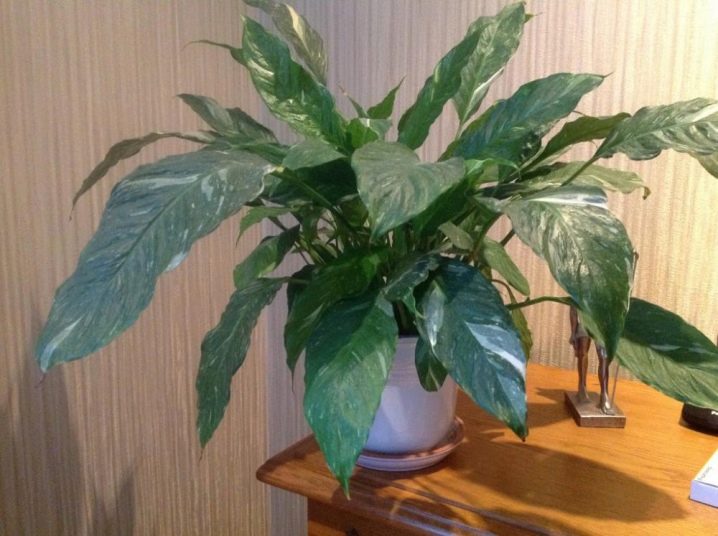
Humidity
Spathiphyllum is a plant that loves a humid climate, so periodically it is worth completely moistening the ground with a flower, spraying or placing a pot on a pallet with wet expanded clay or pebbles. These methods can significantly increase the level of humidity around the crop and create the necessary microclimate for it.
Watering or flooding?
Irregular watering of the plant leads to drying out of the soil, and excess moisture can lead to the death of the flower. The substrate is moistened with a clean filtered liquid, the water temperature is about 22 degrees Celsius. In the summer season, spathiphyllum is watered more often than usual, sometimes up to 4 times a week (it all depends on the ambient temperature, because in hot summer the plant is most vulnerable). In the cold season, watering is reduced, as the absorption of moisture by the horse system slows down, so the risk of flooding the crop increases.
The flower pot is located away from heating appliances, in a place protected from drafts.
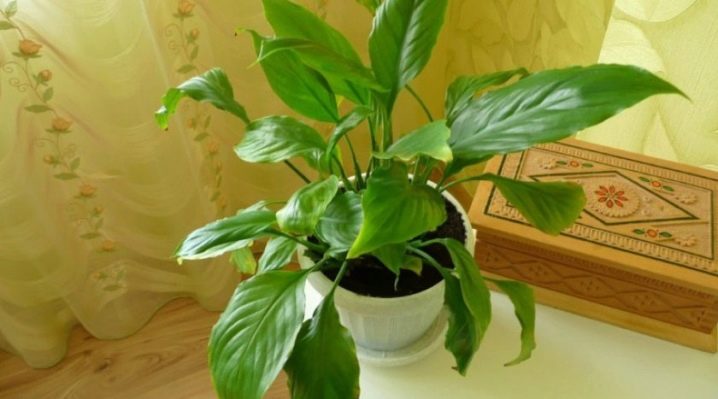
The following signs indicate overdrying of the earthen mixture:
- loss of leaf turgor, hanging of peduncles and leaf plates outside the pot;
- change in leaf color, yellowing, wilting;
Signs of excess moisture are as follows:
- the formation of blackened areas on leaf plates;
- drooping leaves due to the death of the root system;
- development of the process of decay of the root collar, its softening.
When filling the plant, it is recommended to wait for the excess moisture to drain completely and remove the flower from the pot. Wrap the earthen ball with a cloth or napkins so that the material absorbs the liquid. If the soil is not completely rooted, leave it to dry at room temperature out of sunlight for a few hours, then return the plant to the pot.
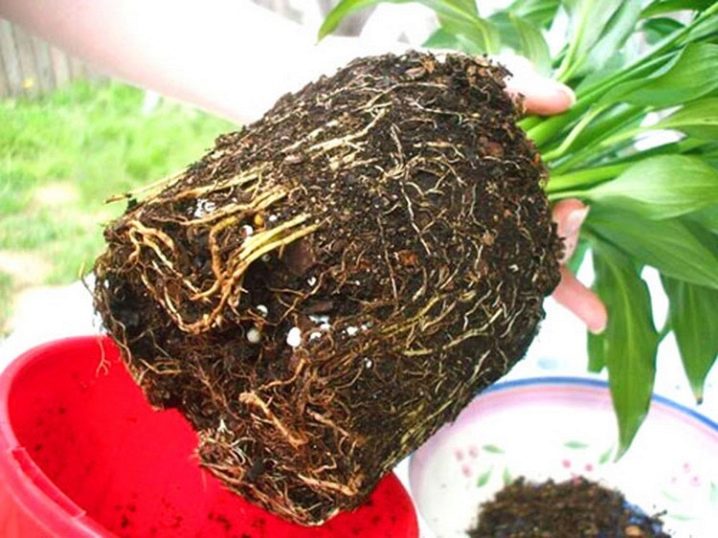
Important! To minimize the risks of spathiphyllum flooding, it is recommended to water the plant through a tray.
Fertilizers: excess and deficiency
This is the most common problem that causes spathiphyllum to not bloom. The introduction of fertilizers into the substrate should be carried out every season, during the period of active vegetation and budding - every week, during the dormant period - once a month. With an excess of fertilizer, the root system is covered with burns, the leaves of the spathiphyllum dry up and wither. Treatment: transplanting a crop into a new earthen mixture with washing out the old soil by irrigating with plenty of water. The lack of nutrients affects the growth of the flower, the plant does not grow green mass well, the flowers or leaf plates are small.
Plant care rules
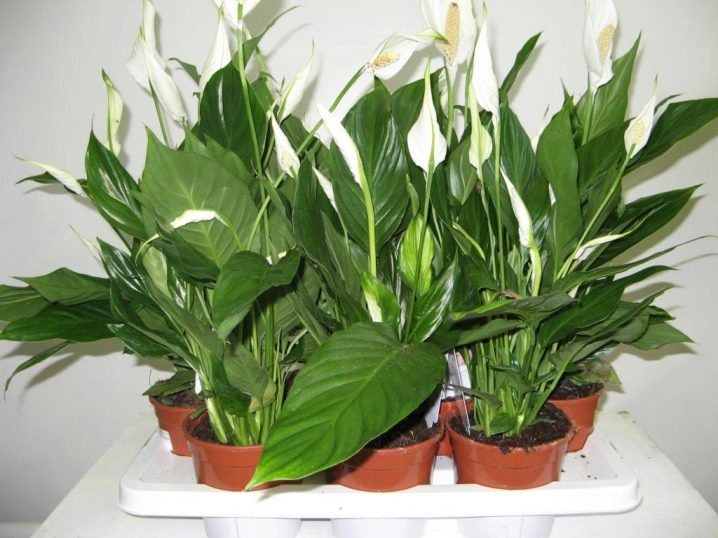
Incorrect transplant
The plant is fast growing. When a culture is transplanted, a complete or partial replacement of the earthen coma occurs, as well as the separation of the flower into a mother plant and children. After placing the spathiphyllum in a new container, the culture begins a rapid growth of the root system, which leads to a lack of flowering. The second reason is the build-up of deciduous mass, it concerns young or damaged plants. The budding period will come after the flower has fully formed into an adult culture.
Potting problem
Finding "female happiness" in the wrong substrate can affect poor development of flower buds.The plant prefers slightly acidic soil with the addition of organic matter, leaf and sod land, peat, coal, and the presence of drainage. The substrate must be loose, since air circulation is important for the root system of the flower. Dense or packed soil affects the growth and condition of the culture, delaying the moment of budding.
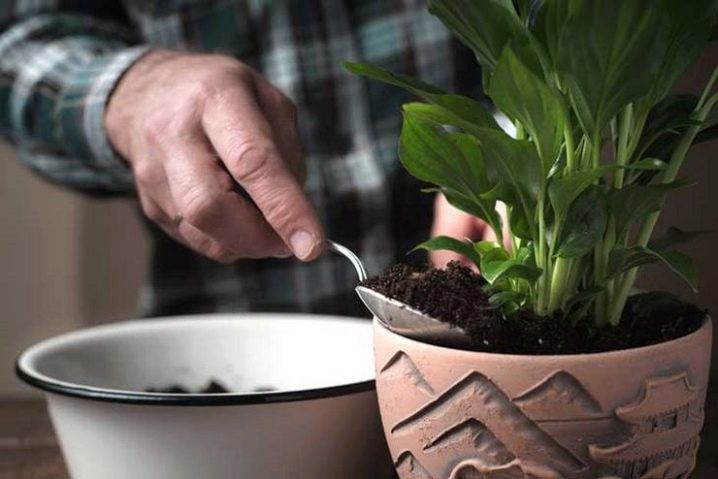
What to do?
There are various tricks for spathiphyllum to bloom. It is necessary to create a kind of "stress" for the culture.
Important! With all changes, the flower must always receive a sufficient amount of light.
Spathiphyllum can be made to bloom by the following methods:
- rearrangement of the plant in a cold room or refrigerator with a temperature of at least 16 degrees Celsius;
- reduce watering frequency cultures, and when dry tips appear on the leaf plates, it is necessary to carefully cut these zones to healthy tissues; the soil should be regularly dried before watering;
- obligatory loosening the upper part of the substrate after watering;
- during flowering culture fertilized with the content of potassium and phosphorus 1 time every week;
- make spathiphyllum a warm bath or spray with water every day, morning and evening; it is necessary to dilute a special preparation in the liquid, for example, "Zircon", which helps to increase immunity, feed "Bud" or "Domotsvet" - a substance that stimulates the formation of flower buds;
- removal of old leaves and shoots;
- check the crop for pests - ticks, thrips, worms and so on; if the result is positive, immediately treat the plant with special substances and quarantine it.
If all of the above methods did not help, then the reason for the absence of flower ovaries is associated with the age of the culture. Old plants do not have enough strength to enter the budding period, so they should be planted in different containers. After transplantation, the spathiphyllum will begin to grow green mass and in the future is able to bloom again on new shoots.
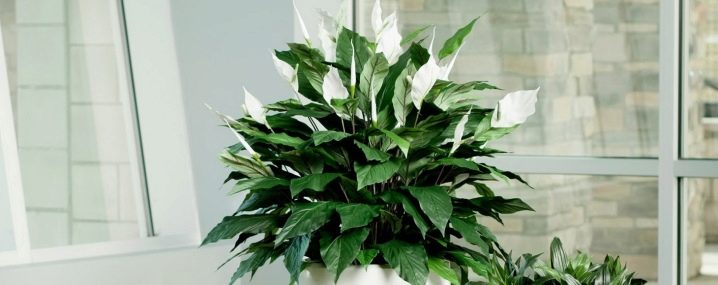
It is quite easy to take care of the plant; both a beginner and an experienced florist will cope with this task. It is worth adhering to several recommendations for caring for spathiphyllum at home.
- The flower should not be placed in a very dark place., the plant calmly tolerates shade and partial shade, but the complete absence of sunlight can lead to the death of the flower, the leaf plates will decrease in size, the culture will not be able to enter the flowering period. "Women's happiness" grows better on the northern windows. On the south side, the flower needs shelter from direct sunlight. It is also important to protect the culture from drafts.
- Suitable temperature for growing spathiphyllum at home is + 22– + 23 degrees. The plant begins to bloom at 16-18 degrees of heat.
- Humidity... The culture prefers humid air, it is advisable to spray the plant every day in the morning and in the evening. When maintaining the culture of a house with the heating turned on, it is worth taking care of additional sources of moisture - a bowl of water, an air humidifier, a container with wet expanded clay, on which a pot with a plant is placed. These methods help control moisture levels and help the flower adapt during the winter months.
- Watering... During the growing season and flowering, the plant should be watered more often than usual. The liquid should be warm, up to +23 degrees, separated or passed through a filter. Stagnation of water in a pot or pallet will lead to waterlogging of the soil and rotting of the plant roots, and there is also the possibility of the development of fungal diseases. Watering is recommended through the pan, draining the remaining liquid after 10 minutes, or superficially, trying not to flood the growth points of the culture.
- Substrate... Spathiphyllum is planted in a soil mixture consisting of leafy and soddy lands, peat, humus and sand, while it is worth observing the proportions of 2: 1: 1: 1: 1.It is allowed to add sphagnum moss or other substances that help absorb moisture and prevent the soil from drying out. In the presence of such ingredients in the earthen mixture, you should carefully consider the frequency of watering the plant.
- Fertilizers... The flower needs constant feeding, with a lack of nutrients, the flowering cycle is disrupted or it is completely absent. Fertilizers should be applied from early spring to mid-autumn, during a period of active crop growth. Often, the introduction of substances is done once every 2 weeks or a month. Poultry manure, organic matter, complex feeding, mineral preparations are used as fertilizers.
- Transfer spathiphyllum is produced once a year (in spring) or in case of infection of the plant with fungal diseases. A new pot should be picked up 1–2 cm larger than the old one. If the earthen lump was not braided by roots, the plant should be returned to its original place with the replacement of a small amount of soil with a new one.
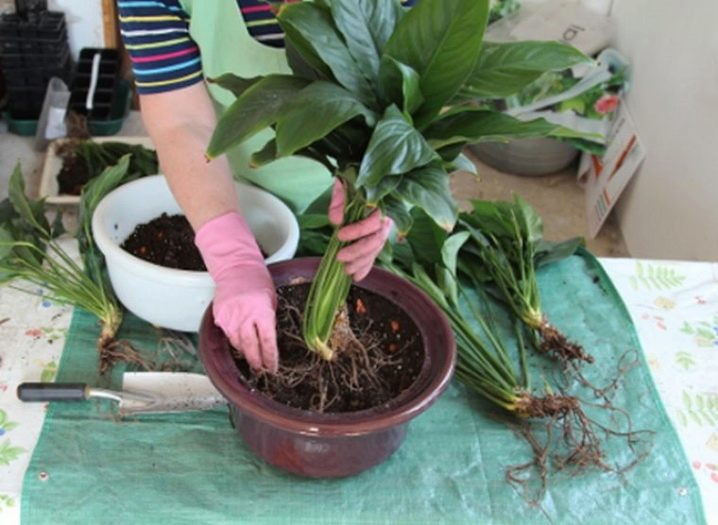































The comment was sent successfully.